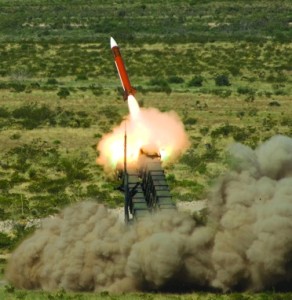About High Frontier—Past, Present, Future
For over three decades, High Frontier has been among the nation’s leading non-government authorities on missile defense issues including missile defense, arms control, nuclear weapons, and strategic systems. Our funding comes from the private sector and individuals who seek effective defenses against ballistic missile attack. Through our publications, research and personal contacts—from the grass roots to one-on-one contacts with leaders in Washington, we provide a powerful voice that actively supports the deployment of an effective defense against ballistic missiles.
 In 1982, High Frontier’s founder and an advisor to President Ronald Reagan, Lt. General Daniel O. Graham, published a report entitled, “High Frontier: A New National Strategy.” At the President’s request, General Graham’s sought answers in U.S. technology, especially space technology, to the strategic problems that plague the United States and the world. The foundation of High Frontier concepts was the abandonment of the suicidal and immoral strategy of Mutual Assured Destruction [MAD] for the concept of Assured Survival through the creation of effective defenses against ballistic missiles.
In 1982, High Frontier’s founder and an advisor to President Ronald Reagan, Lt. General Daniel O. Graham, published a report entitled, “High Frontier: A New National Strategy.” At the President’s request, General Graham’s sought answers in U.S. technology, especially space technology, to the strategic problems that plague the United States and the world. The foundation of High Frontier concepts was the abandonment of the suicidal and immoral strategy of Mutual Assured Destruction [MAD] for the concept of Assured Survival through the creation of effective defenses against ballistic missiles.
In no small measure, President Reagan adopted General Graham’s recommendations and voiced them to the world in his March 23, 1983 televised speech, “Defense and National Security.” (Click on the adjacent SDI shield to hear the pertinent portions of this important speech.) President Reagan met the missile threat head on and called on America’s community of scientists “to turn their great talents now to the cause of mankind and world peace, to give us the means of rendering these nuclear weapons impotent and obsolete.” That night President Reagan began a new comprehensive research and development plan that manifested itself as the Strategic Defense Initiative [SDI], sometimes referred to as “Star Wars.”
On High Frontier’s tenth anniversary, President Reagan thanked Danny Graham and the High Frontier for its efforts. Click here or on President Regan’s photo to the right to hear his comments.
 SDI continued under President George H.W. Bush and was expanded and strengthened under the leadership of Ambassador Henry F. (Hank) Cooper, who previously served as President Reagan’s Chief Negotiator with the Soviet Union at the Geneva Defense and Space Talks and SDI director under President George H. W. Bush. Despite the success of SDI in bringing down the Soviet Union and gaining substantial international support for a specific architecture called Global Protection Against Limited Strikes (GPALS), the Clinton administration scuttled its efforts and sharply curtailed its budget. High Frontier responded with a major effort to reverse these trends, and was at least partially successful effort under the Ambassador Cooper, who next picked up the High Frontier baton from Danny Graham. But work still remains to realize President Reagan’s vision.
SDI continued under President George H.W. Bush and was expanded and strengthened under the leadership of Ambassador Henry F. (Hank) Cooper, who previously served as President Reagan’s Chief Negotiator with the Soviet Union at the Geneva Defense and Space Talks and SDI director under President George H. W. Bush. Despite the success of SDI in bringing down the Soviet Union and gaining substantial international support for a specific architecture called Global Protection Against Limited Strikes (GPALS), the Clinton administration scuttled its efforts and sharply curtailed its budget. High Frontier responded with a major effort to reverse these trends, and was at least partially successful effort under the Ambassador Cooper, who next picked up the High Frontier baton from Danny Graham. But work still remains to realize President Reagan’s vision.
Many of today’s operational missile defense systems owe their Heritage to the GPALS concept from the first Bush administration. When George W. Bush withdrew from the ABM Treaty it became possible to develop, test and deploy the truly effective defenses that President Reagan wanted,  including those in outer space. However, no space-based defense program, which was the centerpiece of Reagan’s vision, continues as a serious effort today—a continuing challenge for High Frontier and the advocates for truly effective defenses. To view a video of Former Navy Secretary Don Winter and Ambassador Cooper’s discussion of this important era that set the stage for today’s missile defense programs, click on the adjacent photo to view the proceedings of the 2010 Ronald Reagan Award for his stewardship.
including those in outer space. However, no space-based defense program, which was the centerpiece of Reagan’s vision, continues as a serious effort today—a continuing challenge for High Frontier and the advocates for truly effective defenses. To view a video of Former Navy Secretary Don Winter and Ambassador Cooper’s discussion of this important era that set the stage for today’s missile defense programs, click on the adjacent photo to view the proceedings of the 2010 Ronald Reagan Award for his stewardship.
Of particular note is the Navy’s Aegis ballistic missile defense system, the development of which began on Ambassador Cooper’s SDI watch and which now is deployed around the world on more than 24 Aegis Cruisers and Destroyers, growing to 32 by 2015. Even testing such a system was not permitted under the terms of the ABM Treaty, if it could defend Americans at home. After beginning in 1992 as a Theater Missile Defense system to defend our overseas troops and allies, it is now finally being given the capability to defend Americans at home—to become a truly global defense system.
 All currently deployed ground based systems were part of Ambassador Cooper’s GPALS architecture over twenty years ago. Ground-based interceptors in Alaska and California defend North America against ICBMs that might be launched from North Korea or Iran. Our Theater Missile Defenses, such as Patriot and THAAD, protect our troops and allies. U.S. citizens paid most of the
All currently deployed ground based systems were part of Ambassador Cooper’s GPALS architecture over twenty years ago. Ground-based interceptors in Alaska and California defend North America against ICBMs that might be launched from North Korea or Iran. Our Theater Missile Defenses, such as Patriot and THAAD, protect our troops and allies. U.S. citizens paid most of the
development costs of the Israeli missile defenses, currently so important in Israel’s (and our) face-off with Iran. And we have numerous joint programs with other allies, such as with Japan which brought billions to the table to help develop Aegis sea-based missile defenses now jointly deployed against North Korea and others.
But High Frontier’s job still isn’t done. The ground based defenses of North America have limited capability and need to be strengthened and developed further. Our existing sea-based defenses need to be improved, including to give them an effective capability against ICBMs while they are either stationed near our coasts or in the neighborhood of nations who might attack America—there they could shoot down attacking missiles while they are in their ascent phase of flight. A land-based “Aegis Ashore” version, to be deployed in central Europe (Romania and Poland) by 2015, should also be deployed at U.S. coastal military bases around the Gulf of Mexico, from which Iran or terrorists might launch an EMP attack that could ultimately kill two-thirds or more or all Americans. We are totally vulnerable to this attack today.
Please click on the picture below to view a brief video on EMP effects
Please take a few minutes to watch what could happen if the United States was to face the event of an Electro-Magnetic Pulse (EMP). As discussed in a recent article, this threat is potentially a modern Cuban Missile Crisis, that like its 1962 predecessor poses an existential threat to all Americans.
And a major effort is needed to revive the centerpiece of Ronald Reagan’s SDI program, space based defenses. These were the most advanced of Amb. Cooper’s SDI programs when he departed the scene on January 20, 1992. The Clinton administration scuttled the program and dispersed the government and industry team that had been developing that system. It had been approved by the Pentagon’s Defense Acquisition Board, and congress had appropriated $300 billion for Fiscal Year 1993. Regrettably, neither the George W. Bush nor Obama administrations has invested any funding for even developing key technology that had matured sufficiently to support a fully approved acquisition program in 1991.
These then are High Frontier’s top priorities:
- Fully develop the Aegis Sea based defenses—including against an EMP attack on the United States.
- Revive a space-based defense program to provide a global defense, effective against ballistic missiles in all their phases of flight.
- Support improvements to existing missile defenses, including the ground-based defenses of the United States and the Theater Missile Defenses for our overseas troops, friends and allies.
HIGH FRONTIER IS COMMITTED TO ENSURING THE NATION IS DEFENDED AGAINST THE THREAT OF BALLISTIC MISSILES.
High Frontier is a 501[c]3 non-profit organization dedicated by our charter to the study, research and education in the scientific, technical, military and strategic problems of building effective ballistic missile defenses. All donations to High Frontier are 100% tax-deductible. Please visit our Contact page to make a donation to High Frontier.



